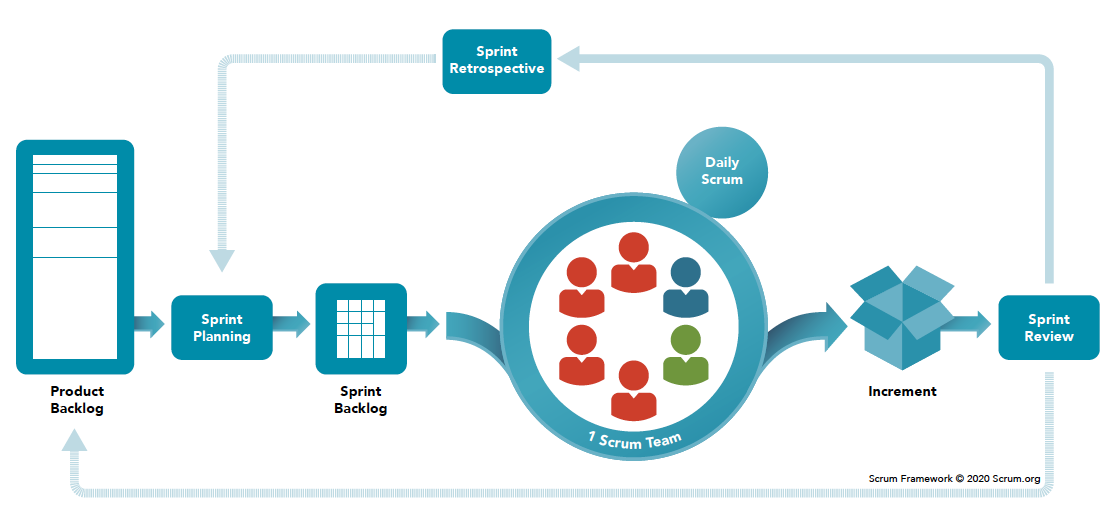Team Iteration Planning: Sprint Planning for Your Scrum Team
By Team Lean Agile Intelligence

Sprint Planning For Scrum Team
Sprint planning is one of the core events of Scrum, where the scrum team plans what the goal will be and how to achieve it for the upcoming sprint. The entire team participates, and the Product Owner identifies how the product can increase its value in the upcoming sprint. The team then collaborates on the sprint goal, selects the PBIs to achieve the sprint goal, and uses its Definition of Done, upcoming Sprint capacity, and past performance to gauge what they can commit to.
In this post, we discuss the best practices of Team Iteration Planning. Following the foundational techniques at different stages of your learning journey, you can ensure to learn about the best strategies to bring back to the team. However, Team Iteration Planning is just one part of the big picture, if you want a holistic view of your team's current process status, take advantage of our free agile assessment for Team Agility.
Team Iteration Planning and The Learning Journey
At Lean Agile Intelligence, we recognize Team Iteration Planning as the team's ability to plan small product increments on cadence and enable change. We divided the learning journey into 4 different stages: Developing, Emerging, Adapting, and Optimizing. In the following sections, we will discuss each stage in detail as well as provide practical tips and techniques to help you extend your skills in this area.

Source - What is Scrum?
Developing
Teams “developing” an understanding of the value of Team Iteration Planning and adopting the foundational techniques should focus on the following improvements
-
The What: Team Iteration Planning occurs on cadence; at the beginning of every Iteration (i.e., Spring)
-
The How: Sprint planning is the first event of a sprint. As an event, it’s critical it is on a scheduled cadence. A recommended start point is every two weeks for 2 hours (For a 2-week sprint). Being on a cadence simply means the meeting is happening at the same time at each interval. This way team members and external attendees can properly plan and consistently attend. According to the Scrum Guide, The timebox for Sprint Planning is no longer than four hours for a one-month Sprint.
-
-
The What: The plan for the upcoming Iteration aligns with a specific goal (i.e., Spring Goal)
- The How: Here are some tips to ensure that the plan for the upcoming Iteration aligns with a specific goal
- Design a clear Sprint Goal: As a team define a clear Spring Goal that is a concise statement that describes the overall objective or purpose of the iteration. This provides a guiding direction for the team to align their efforts and focus their work during the iteration. Then review and prioritize the product backlog
- Product Owner review and prioritize the product backlog: “The Product Owner is accountable for maximizing the value of the product resulting from the work of the Scrum Team.” - Scrum Guide 2020. The product owner uses previous releases to inform their priorities for upcoming sprints. It’s important to have the product backlog prioritized prior to sprint planning and come in with some ideas for a preliminary sprint goal. For a more in-depth look at this subject, Bob Galen has a great PDF where he outlines his personal tips for sprint planning. You can find that PDF here.
- Break down work into manageable tasks: Once the product backlog items are prioritized, work with the team to break them down into smaller, manageable tasks. These tasks should be specific and clearly defined, with clear acceptance criteria.
- Estimate and allocate work: Use techniques such as story points, time-based estimates, or relative sizing to estimate the tasks. Allocate the tasks to team members based on their skills, availability, and capacity. Ensure that the allocated tasks align with the Sprint Goal and the team's overall capacity for the iteration.
- Review progress against the Spring Goal: Use techniques such as daily stand-ups, task boards, and burndown charts to track progress and ensure that the team is making progress towards achieving the Sprint Goal. If any deviations or changes occur during the iteration, reassess and adjust the plan as needed to realign with the Sprint Goal.
- Design a clear Sprint Goal: As a team define a clear Spring Goal that is a concise statement that describes the overall objective or purpose of the iteration. This provides a guiding direction for the team to align their efforts and focus their work during the iteration. Then review and prioritize the product backlog
- The How: Here are some tips to ensure that the plan for the upcoming Iteration aligns with a specific goal

Emerging
Teams “emerging” beyond the foundational techniques of Team Iteration Planning and are embracing it as they become more proficient, should focus on the following improvements
-
The What: The right people participate in Team Iteration Planning to create a shared understanding of the work and have confidence in the plan
-
The How: Sometimes SMEs outside the team may be required to assist in sprint planning. Ideally, they would be involved in the refinement process prior to sprint planning but even then, they may be required to attend to answer questions. Ensure the SME is aware that their attendance is needed at least a week prior to the event and that they understand what their expectations of them are at the meeting.
-
-
The What: The team actively engages with dependent teams before and during Iteration (i.e., Sprint) to ensure alignment, integration, and quality
-
The How: Here are the strategies that the team can use to ensure alignment, integration, and quality when engaging with dependent teams before and during Iteration:
- Foster Collaborative Communication: Agile teams should foster a culture of collaborative communication and actively engage with dependent teams before and during an iteration (sprint). This includes establishing open channels of communication, such as regular team meetings, joint planning sessions, and shared documentation, to facilitate alignment, integration, and quality.
- Conduct Joint Planning and Review Sessions: Joint planning sessions can involve representatives from dependent teams to review and align their backlog items, identify dependencies, and plan their work accordingly. Joint review sessions can be used to showcase integrated work and gather feedback from dependent teams to ensure that quality standards are met and integration is smooth.
- Establish a Shared Definition of Done (DoD): Agile teams can establish a shared Definition of Done (DoD) with dependent teams to ensure alignment and quality. Visit this previously published blog post, for an in-depth look at the Definition of Done. A shared DoD clearly outlines the criteria that must be met for work items to be considered complete, including integration, testing, documentation, and other quality-related activities.
- Foster Cross-Team Collaboration: Agile teams should foster a culture of cross-team collaboration and actively encourage team members to work across team boundaries to ensure alignment, integration, and quality. This can include practices such as cross-team pairing, shared code reviews, and collaborative documentation, which promote active engagement and collaboration between teams.
- Foster Collaborative Communication: Agile teams should foster a culture of collaborative communication and actively engage with dependent teams before and during an iteration (sprint). This includes establishing open channels of communication, such as regular team meetings, joint planning sessions, and shared documentation, to facilitate alignment, integration, and quality.
-
* * * * * *
"One of the fundamental aspects of a scrum team is achieving common tangible product and team goals."
* * * * * *
Adapting
Teams “adapting” the Team Iteration Planning practice to extract the full benefit, should focus on the following improvements
-
The What: The team has a Multi-Iteration plan (i.e., release plan, quarterly plan) that provides a look-ahead for multiple Iterations of work that calls out forecasted delivery dates, and dependencies
- The How: Establish a shared understanding of the multi-iteration plan. Start by reviewing and discussing the multi-iteration plan with the team during the iteration planning. Ensure that all team members have a clear understanding of the overall goals, forecasted delivery dates, and dependencies outlined in the plan. This helps the team to align their work with the bigger picture and ensures that they are aware of the upcoming work and deadlines
- The How: Break down the multi-iteration plan into actionable items. These actionable items could be user stories, tasks, or other work items that are aligned with the goals and dependencies identified in the multi-iteration plan. This helps the team to translate the high-level plan into concrete work that can be planned and executed in iterations
- The How: Collaborate with other teams and stakeholders as well as account for cross-functionality. A high-performing scrum team develops its cross-functional skills over time to be able to remove bottlenecks and increase its own quality. At sprint planning, teams should consider their goals related to growing skillsets and look for opportunities to work together during the sprint. Andy Cleff has a fantastic blog post that outlines steps to do this in-depth titled “Six Steps to Self Learning Teams and Organizations” which can be found here.
- The How: Establish a shared understanding of the multi-iteration plan. Start by reviewing and discussing the multi-iteration plan with the team during the iteration planning. Ensure that all team members have a clear understanding of the overall goals, forecasted delivery dates, and dependencies outlined in the plan. This helps the team to align their work with the bigger picture and ensures that they are aware of the upcoming work and deadlines

Source - Your Team Won't Think of Everything in Sprint Planning Meetings. And That's OK.
Optimizing
Teams “optimizing” the knowledge sharing of the Team Iteration Planning practice learnings across the enterprise should focus on the following improvements
-
The What: The team's Multi-Iteration plan (i.e., release plan, quarterly plan) is used as an effective means of "connecting" the work being done by the team to the organization's short-term and long-term goals
-
The How: Start with the organization's goals then align work items with goals. During the iteration planning process, begin by revisiting and reinforcing the organization's short-term and long-term goals. Ensure that each work item is mapped to a specific goal or objective that it contributes to. This ensures that the team's work is purposeful and directly connected to the desired outcomes of the organization.
- The How: Make sure to continuously update the multi-iteration plan. Keep the multi-iteration plan, such as a release plan or quarterly plan, up-to-date with the latest information about the organization's goals and priorities. Regularly review and update the plan based on changes in business objectives, customer feedback, or other factors that may impact the team's work. This helps to maintain the relevancy and effectiveness of the plan in connecting the team's work to the organization's goals.
-
* * * * * *
"A high-performing scrum team develops its cross-functional skills over time to be able to remove bottlenecks and increase its own quality."
* * * * * *
Conclusion
In conclusion, Team Iteration Planning or sprint planning is an essential event for the Scrum framework, and it sets the foundation for a successful sprint. The entire scrum team should participate, and the product owner should have the product backlog prepared and prioritize it before sprint planning. The sprint goal should be formulated and finalized during the planning, and the team should decide which product backlog items to pick up based on current priorities and their capacity. As the team becomes more proficient, they can focus on improving their techniques by inviting subject matter experts and using their definition of done, sprint capacity, and past performance to determine what they can commit to. By continuously refining their sprint planning process, Scrum teams can ensure that they achieve their sprint goals and deliver value to their customers. If you want to gain a comprehensive understanding of your team’s current process status, we recommend taking advantage of our free agile assessment for Team Agility.